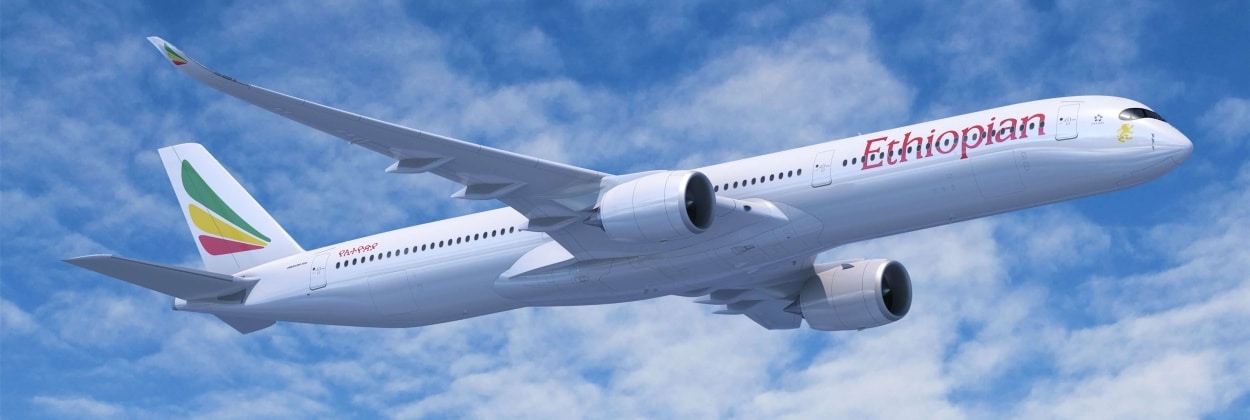Aerospace
Ethiopian Airlines orders Africa’s first A350-1000
The largest airline company in Africa, Ethiopian Airlines Group, has upgraded four of its A350-900 orders to the A350-1000, the largest model in the A350 Family

The largest airline company in Africa, Ethiopian Airlines Group, has upgraded four of its A350-900 orders to the A350-1000, the largest model in the A350 Family, making it the continent’s first user of the aircraft.22 A350-900s have previously been ordered by Ethiopian Airlines, 16 of which have already been delivered. Ethiopian Airlines now has a backlog of four A350-1000s and two A350-900s with the A350-1000 upsizing.
Ethiopian Airlines
By launching the A350-1000, the largest model of the world’s most effective and technologically advanced passenger aircraft. Ethiopian Airlines is once again setting a standard in Africa’s aviation industry, remarked by Mikail Houari, president of Airbus Africa and the Middle East.
A350-1000 to its fleet of modern wide-body aircraft
The A350-900 has offered unparalleled operational flexibility and efficiency, from short to ultra-long range operations, combined with remarkable capability, fuel efficiency, and operational reliability of 99.5 percent .By adding the A350-1000 to its fleet of modern wide-body aircraft, the East African carrier will increase its capacity. The airline will benefit from a versatile, highly advantageous Family that makes use of Airbus’ excellent degree of commonality and same type rating.
Modern aerodynamics, a fuselage and wings made of carbon fibre, as well as the most fuel-efficient Rolls-Royce Trent XWB engines, are all part of the Airbus A350’s brand-new, original design. By combining these advanced technologies, Ethiopian Airlines achieves incredible levels of operational effectiveness and sustainability, with a 25% reduction in fuel consumption and CO2 emissions compared to twin-aisle aircraft of earlier generations.
940 orders from 52 customers were placed on the A350 Family by the end of June 2022, making it the standard large wide body family for the ensuing decades.

Aerospace
Boeing Transfers Rocket Stage to NASA, Paving Way for Human Moon Mission

Boeing has achieved a significant milestone by providing NASA with the second core stage of the Space Launch System (SLS) rocket.
This crucial component, crafted at NASA’s Michoud Assembly Facility (MAF), is set to propel the Artemis II crew into lunar orbit, marking humanity’s return to deep space after a 50-year hiatus.
The monumental Boeing-built rocket stage, the largest element of the Artemis II mission, will embark on a journey aboard the Pegasus barge, traveling 900 miles to NASA’s Kennedy Space Center.
Comparison of two legendary aircraft B777x vs B747 aircraft:Click here
Upon arrival, it will be meticulously integrated with other essential Artemis II components, including the upper stage, solid rocket boosters, and NASA’s Orion spacecraft within the iconic Vehicle Assembly Building. This intricate integration process is a vital step toward the eagerly anticipated Artemis II launch, slated for 2025.
“Boeing-built products helped land humankind on the moon in 1969, and we’re proud to continue that legacy through the Artemis generation,” remarked Dave Dutcher, vice president and program manager for Boeing’s SLS program. “Together, with NASA and our industry partners and suppliers, we are building the world’s most capable rocket and paving the way to deep space through America’s rocket factory in New Orleans.”
NASA, Lockheed Martin Reveal X-59 Quiet Supersonic Aircraft:Click here
The delivery of Core Stage 2 marks a significant achievement in the evolution of the SLS rocket. Towering over 200 feet and powered by four RS-25 engines, this core stage, coupled with two solid-fueled booster rockets, will generate a staggering 8.8 million pounds of thrust. This immense power is crucial to launching Artemis II and future missions into the vast expanse of space.
The SLS rocket stands unparalleled in its capability to transport both crew and substantial cargo to the moon and beyond in a single launch. Its extraordinary capacity will facilitate the delivery of human-rated spacecraft, habitats, and scientific missions to destinations including the moon and Mars, ushering in a new era of space exploration.
-

 Travel1 week ago
Travel1 week agoAir India to Expand US Operations with Three New Routes After a Decade
-

 Travel2 weeks ago
Travel2 weeks agoWhy We Should Avoid These Stamps in a Passport
-

 Airlines1 month ago
Airlines1 month agoInvestigations Reveal Fake Chinese Titanium in Boeing and Airbus Jets
-

 Tech4 weeks ago
Tech4 weeks agoChina’s CATL Plans 1,800-Mile Electric Plane Launch by 2027
-

 Airport3 days ago
Airport3 days agoTop 10 Largest Airports in the World by Size
-

 Aerospace4 weeks ago
Aerospace4 weeks agoChina’s Fighter Jets Turn Wings into Autonomous Drones
-

 Airlines4 days ago
Airlines4 days agoAir India Rolls Out A350s for Delhi-New York JFK and Newark Routes
-

 Defence3 weeks ago
Defence3 weeks agoBoeing Enhances Chinook with New Engines and Block II Upgrades at $96 Million







